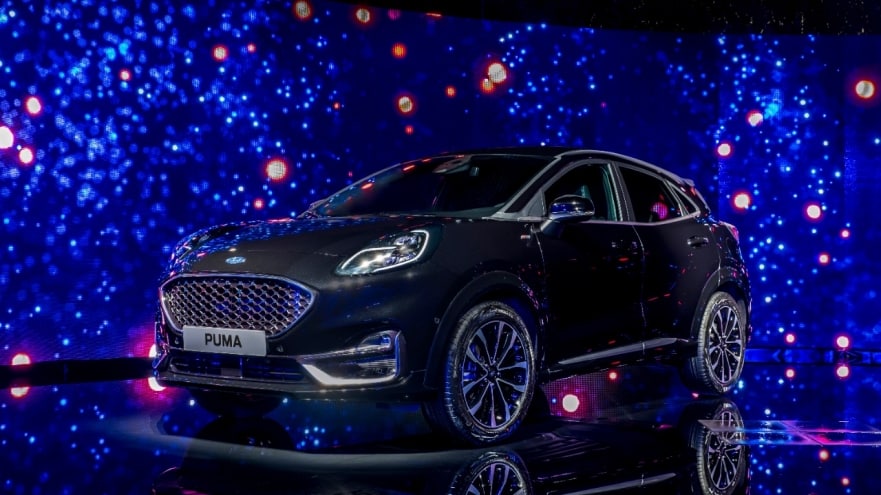Ford has further expanded the new Puma range with additional powertrain and equipment level options – offering the most comprehensive line-up yet for the SUV-inspired compact crossover.
Customers can now for the first time choose from Puma models featuring Ford’s 120 PS 1.5-litre EcoBlue diesel engine, Pumas equipped with a new seven-speed dual-clutch automatic transmission, and a luxurious new Puma ST-Line Vignale variant.
Ford has invested approximately €200 million at its state-of-the art manufacturing facility in Craiova, Romania, to support production of Puma, taking Ford’s total investment in Craiova to almost €1.5 billion since 2008.
Comprehensive powertrain line-up
Puma’s new 120 PS 1.5-litre EcoBlue diesel engine offers a compelling option for high-mileage drivers – delivering from 99 g/km CO2 emissions and 3.8 l/100 km fuel efficiency NEDC (from 118 g/km and 4.5 l/100 km WLTP) with a six-speed manual transmission.
A new seven-speed automatic transmission option for the 125 PS 1.0-litre EcoBoost engine delivers from 110 g/km CO2 emissions alongside 4.9 l/100 km fuel efficiency NEDC (from 137 g/km and 6.0 l/100 km WLTP). The advanced transmission’s greater number of gear ratios and dual-clutch operation for seamless gear changes contribute to optimised fuel efficiency, refinement and driving dynamics.
Puma customers were from late last year among the first to benefit from Ford’s 48-volt mild hybrid technology for enhanced petrol fuel efficiency. Puma EcoBoost Hybrid powertrains are offered with two power outputs in combination with six-speed manual transmissions:
- 125 PS 1.0-litre EcoBoost Hybrid delivering from 97 g/km CO2 emissions and 4.3 l/100 km fuel efficiency NEDC (from 126 g/km and 5.5 l/100 km WLTP)
- 155 PS 1.0-litre EcoBoost Hybrid delivering from 99 g/km CO2 emissions and 4.4 l/100 km fuel efficiency NEDC (from 126 g/km and 5.5 l/100 km WLTP)
The six-speed manual 125 PS 1.0-litre EcoBoost delivers from 103 g/km CO2 emissions and 4.5 l/100 km fuel efficiency NEDC (131 g/km and 5.7 l/100 km WLTP), and the 95 PS 1.0-litre EcoBoost from 102 g/km CO2 emissions and 4.5 l/100 km fuel efficiency NEDC (from 5.7 l/100 km and 129 g/km WLTP).
Luxurious Puma ST-Line Vignale
Based on the sporty Puma ST-Line variant, the Puma ST-Line Vignale adds even more premium styling and specification. Unique details include a satin aluminium upper grille and surround, ebony lower grille, body-coloured lower rear bumper, and large rear spoiler. Standard specification includes LED headlights, Windsor leather seats, Manacor leather steering wheel, premium B&O Sound System and Ford KeyFree system.
Further Puma variants models including the Trend, Titanium, Titanium X and ST-Line X feature as standard innovative technologies including Ford’s Local Hazard Information, enabled by the FordPass Connect modem,* and the versatile Ford MegaBox storage solution, able to house unstable items up to approximately 115 cm tall – such as houseplants or golf clubs – in an upright position.
Earlier this month, Ford announced that a new Ford Performance Puma ST model will join the range later this year.
Quote
“Customers have told us that they want a range of options to help find a combination of style, equipment, performance and efficiency that’s just right for them. That’s something we committed to delivering with Puma, and with a new Puma ST coming later this year, we’re not finished yet.”
Roelant de Waard, vice president, Marketing, Sales & Service, Ford of Europe
# # #
*Features may require activation
Driver-assist features are supplemental to and do not replace the driver’s attention, judgement and need to control the vehicle.
The declared fuel/energy consumptions, CO2-emissions and electric range are determined according to the technical requirements and specifications of the European Regulations (EC) 715/2007 and (EU) 2017/1151 as last amended. Light Duty Vehicle type-approved using the World Harmonised Light Vehicle Test Procedure (WLTP) will have fuel/energy consumption and CO2-emission information for New European Drive Cycle (NEDC) and WLTP. WLTP will fully replace the NEDC latest by the end of the year 2020. The applied standard test procedures enable comparison between different vehicle types and different manufacturers. During NEDC phase-out, WLTP fuel consumption and CO2 emissions are being correlated back to NEDC. There will be some variance to the previous fuel economy and emissions as some elements of the tests have altered, so the same car might have different fuel consumption and CO2 emissions.

